

Closing Remarks for Speech
Ai generator.
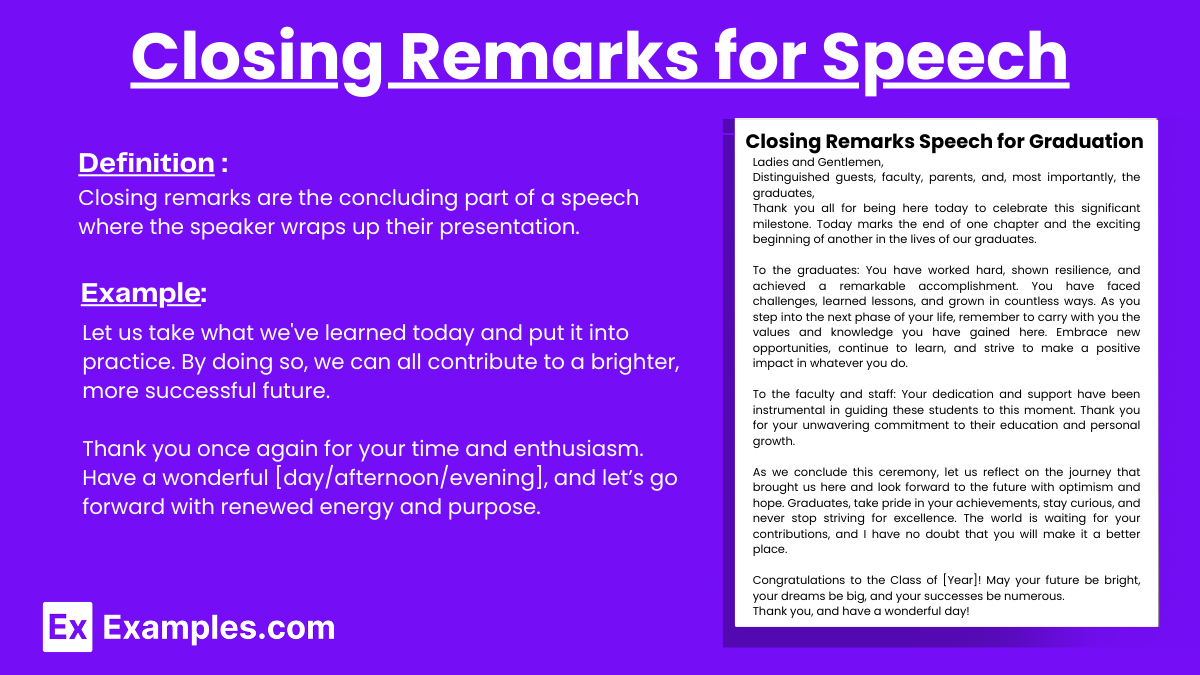
Closing remarks are the concluding part of a Speech where the speaker wraps up their presentation. This section typically summarizes the key points discussed, reinforces the main message, and leaves the audience with a final thought or call to action. Closing remarks are important as they provide a sense of closure and can have a lasting impact on the audience.
What is Closing Remarks for Speech?
Closing remarks are the final statements in a speech, where the speaker brings everything to a conclusion. This part of the speech is designed to recap the main points, emphasize the central message, and offer a final takeaway for the audience. It ensures that the speech ends on a strong note, leaving a lasting impression on the listeners.
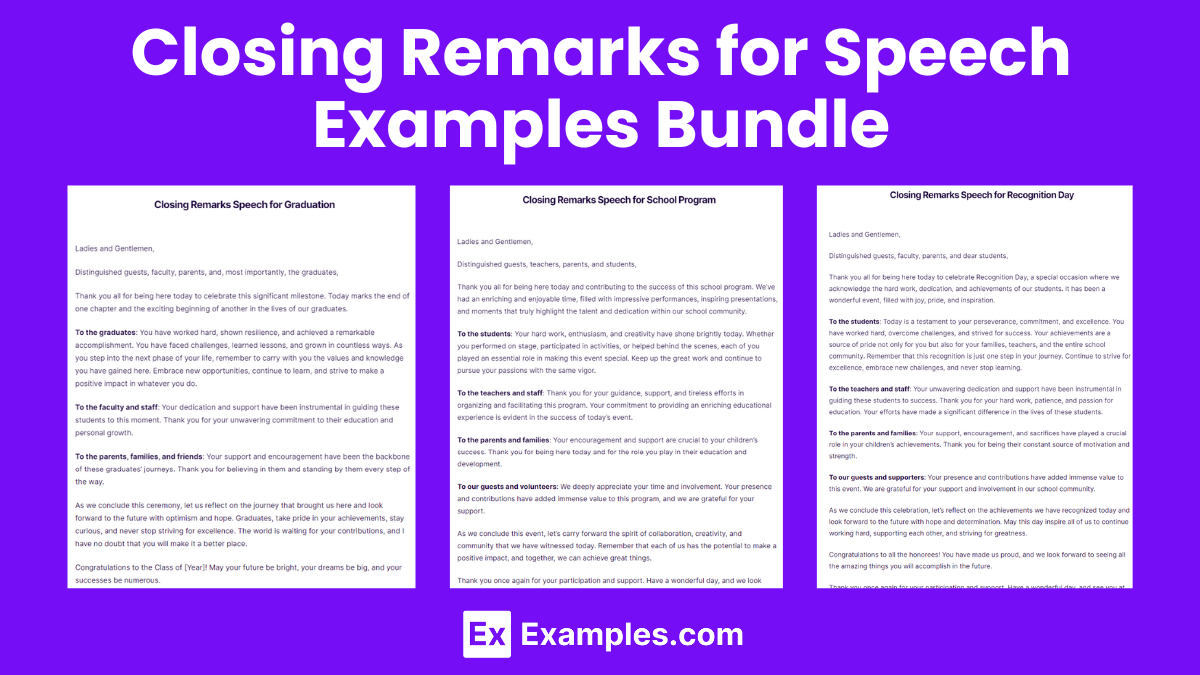
Closing Remarks for Speech Bundle Download
Closing Remarks for Speech Format
1. summarize key points.
Briefly recap the main ideas or arguments presented in your speech. Example : “Today, we discussed the importance of time management, practical strategies to implement it, and the benefits it brings.”
2. Reinforce the Main Message
Emphasize the core message or takeaway you want the audience to remember. Example: “Remember, effective time management is crucial for reducing stress, increasing productivity, and achieving your goals.”
3. Call to Action
Encourage the audience to take specific actions or steps based on your speech. Example: “I encourage each of you to start using a planner, set specific goals, and tackle your most important tasks first.”
4. Thank the Audience
Express gratitude for their time and attention. Example: “Thank you all for your attention and engagement today.”
5. End with a Memorable Closing
Finish with a powerful quote, a thought-provoking statement, or an inspiring note. Example: “As the saying goes, ‘The bad news is time flies. The good news is you’re the pilot.’ Make the most of your time and steer your life towards success.”
Closing Remarks for Speech Example
Today, we’ve explored the importance of effective time management, discussed practical strategies to implement it, and highlighted the numerous benefits it brings. Remember, managing your time well is crucial for reducing stress, increasing productivity, and achieving your goals. I encourage each of you to start using a planner, set specific goals, and tackle your most important tasks first. By doing so, you will take control of your time and pave the way for a more balanced and successful life. Thank you all for your attention and engagement today. As the saying goes, “The bad news is time flies. The good news is you’re the pilot.” Make the most of your time and steer your life towards success. Thank you!
Short Closing Remarks for Speech Example
Today, we explored the importance of effective time management and practical strategies to achieve it. Remember, managing your time well reduces stress, increases productivity, and helps you reach your goals. I encourage you to start using a planner, set specific goals, and tackle your most important tasks first. Thank you for your attention. As the saying goes, “The bad news is time flies. The good news is you’re the pilot.” Make the most of your time and steer your life towards success. Thank you!
Closing Remarks for Speech for Graduation
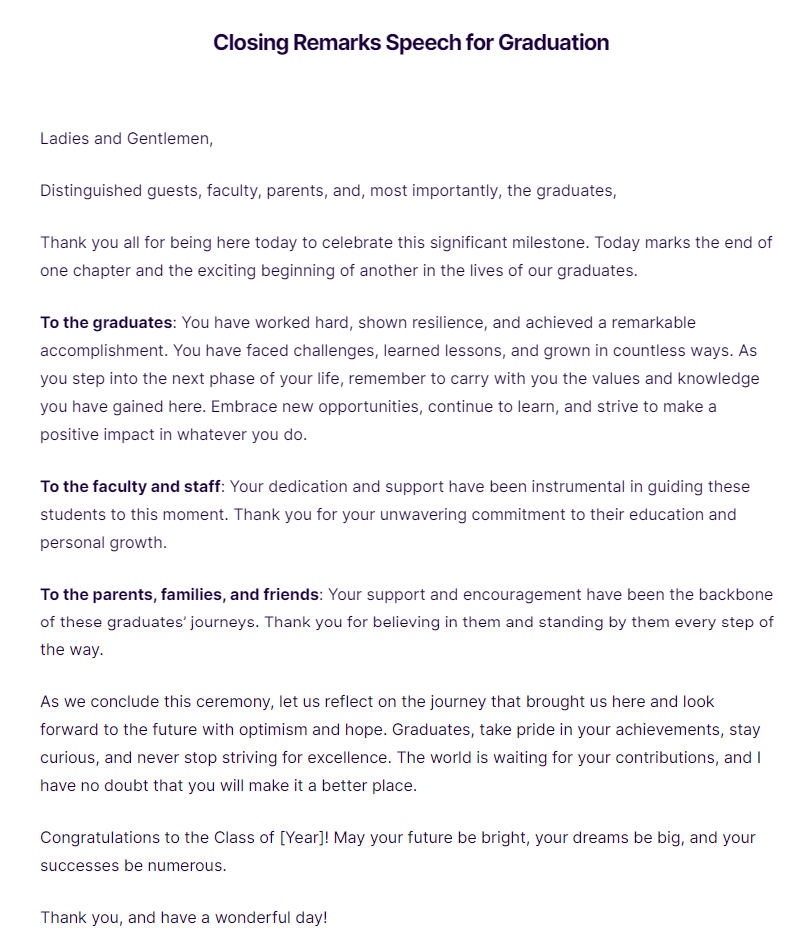
Closing Remarks for Speech for School Program
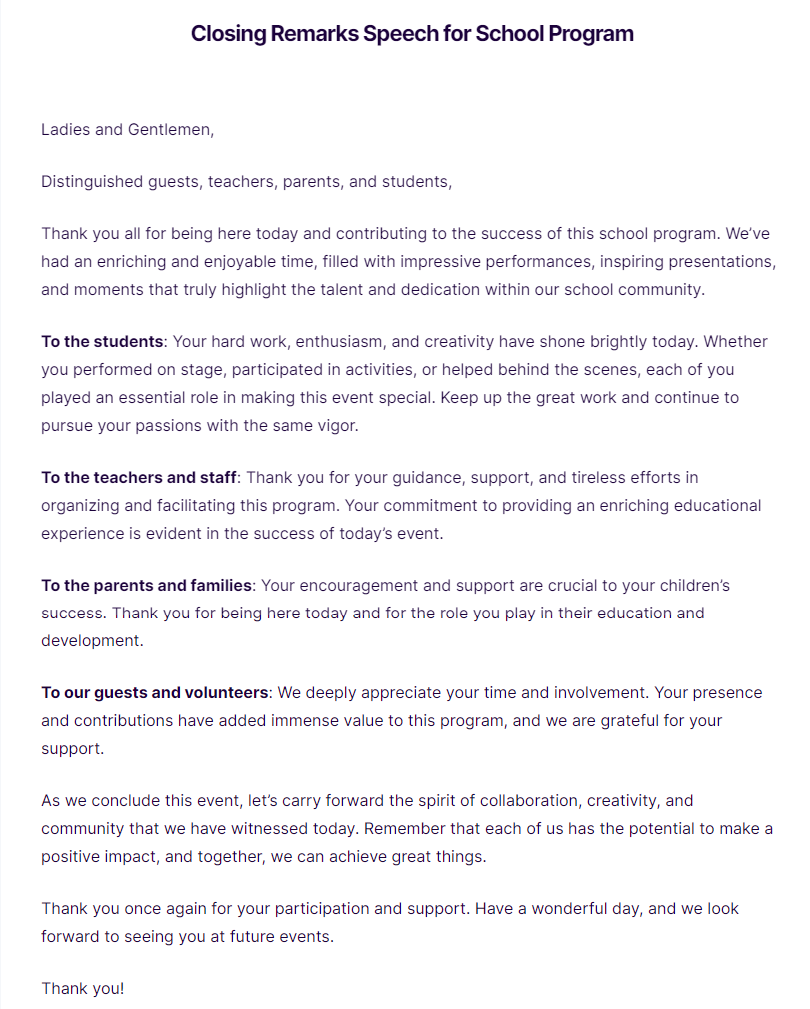
Closing Remarks for Speech for Recognition Day
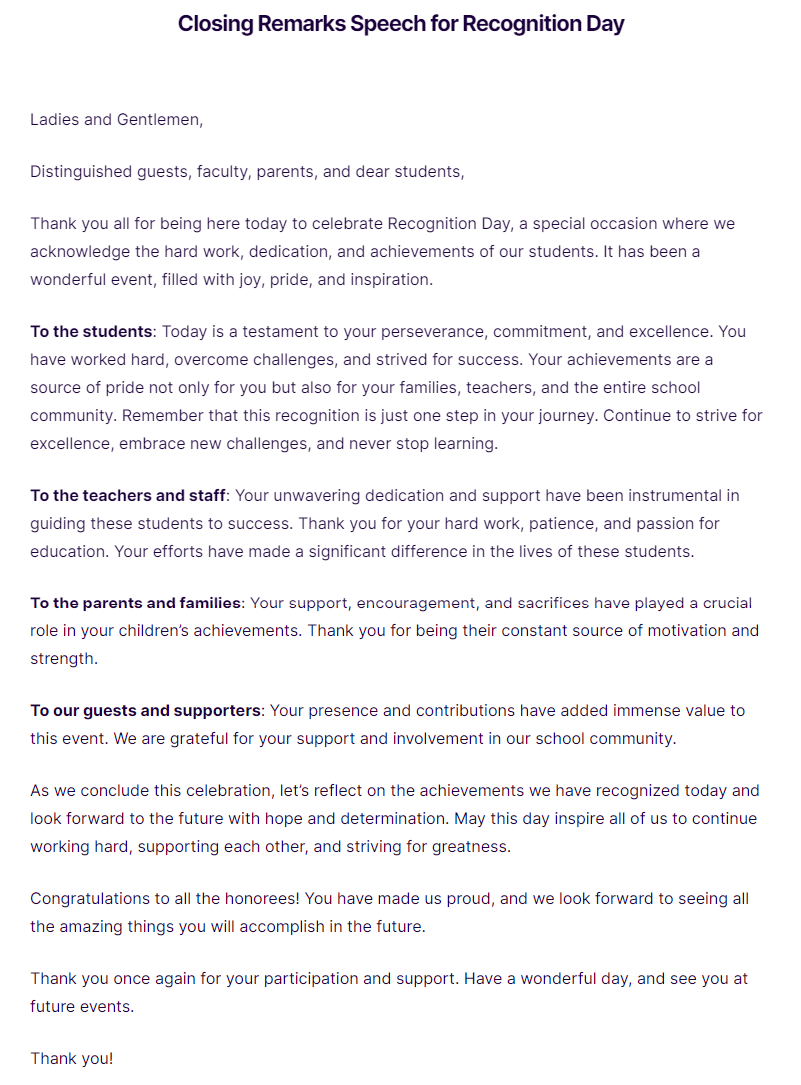
More Closing Remarks for Speech Topics
- Closing Remarks Speech for an Event
- Closing Remarks Speech for Seminar
- Closing Remarks Speech for Teachers Day
- Closing Remarks Speech for Christmas Party
- Closing Remarks Speech for Valedictorian
- Closing Remarks for Speech Contest
- Closing Remarks Speech for Wedding
- Closing Remarks Speech for Conference
- Closing Remarks Speech for Award Ceremony
- Closing Remarks Speech for Farewell
- Closing Remarks Speech for Workshop
- Closing Remarks Speech for Business Meeting
- Closing Remarks Speech for Retirement
- Closing Remarks Speech for Fundraiser
- Closing Remarks Speech for Community Event
- Closing Remarks Speech for Gala
- Closing Remarks Speech for Annual General Meeting
- Closing Remarks Speech for Orientation
- Closing Remarks Speech for Leadership Summit
- Closing Remarks Speech for Charity Event
- Closing Remarks Speech for Memorial Service
- Closing Remarks Speech for Family Reunion
- Closing Remarks Speech for Corporate Event
- Closing Remarks Speech for Product Launch
- Closing Remarks Speech for Training Session
- Closing Remarks Speech for Cultural Festival
- Closing Remarks Speech for Political Rally
How to Write Closing Remarks for Speech
Briefly recap the main ideas or arguments presented.
Example: “Today, we discussed the importance of time management, practical strategies to implement it, and the benefits it brings.”
Emphasize the core message or takeaway you want the audience to remember.
Example: “Remember, effective time management is crucial for reducing stress and achieving your goals.”
Encourage the audience to take specific actions based on your speech.
Example: “I encourage you to start using a planner and prioritize your tasks.”
Express gratitude for their time and attention.
Example: “Thank you all for your attention.”
Finish with a powerful quote, a thought-provoking statement, or an inspiring note.
Example: “As the saying goes, ‘The bad news is time flies. The good news is you’re the pilot.’ Make the most of your time.”
Tips to Deliver Closing Remarks for Speech
1. Summarize Key Points : Briefly recap the main ideas discussed in your speech.
2. Reinforce the Main Message : Emphasize the core message you want the audience to remember.
3. Call to Action : Encourage the audience to take specific steps or actions based on your speech.
4. Express Gratitude : Thank the audience for their time and attention.
5. End with a Memorable Closing : Finish with a powerful quote, thought-provoking statement, or inspiring note.
Why are closing remarks important?
They reinforce the message, ensure audience retention, and provide a clear, memorable conclusion.
How should I structure closing remarks?
Summarize key points, thank the audience, and end with a powerful, memorable statement or call to action.
Can I include a quote in my closing remarks?
Yes, a relevant and impactful quote can effectively reinforce your message and leave a lasting impression.
What should I avoid in closing remarks?
Avoid introducing new information, being too lengthy, or ending abruptly without a clear conclusion.
How do I make my closing remarks engaging?
Use a strong, positive tone, include a personal touch or story, and connect emotionally with the audience.
Can humor be part of closing remarks?
Yes, appropriate humor can leave a positive impression and end your speech on a high note.
How long should closing remarks be?
Closing remarks should be concise, typically lasting no more than a few minutes.
What is a call to action in closing remarks?
A call to action urges the audience to take specific steps or actions related to your speech’s message.
Should I thank the audience in my closing remarks?
Yes, thanking the audience shows appreciation and fosters a positive connection.
Can I use a rhetorical question in my closing remarks?
Yes, a rhetorical question can provoke thought and leave the audience reflecting on your message.
Text prompt
- Instructive
- Professional
10 Examples of Public speaking
20 Examples of Gas lighting
Frantically Speaking
Is your communication holding your career back it's time to change that., become an impactful communicator & 2x your value as professional, what our past students have to say:.

Himanshu Khurana
Technical Manager
“The Frantically Speaking course helped me better my public speaking and communication in a matter of weeks. The curriculum is practical and teaches you to express your thoughts clearly and confidently. If you want to speak up, this training has got you covered!”

Nitin Gupta
Data Engineer
“After the training ended, the poise and confidence I communicate with during meetings and conversations has spiked! The training helped me understand practical techniques which I can apply in my every day life and if you work in any technical field, I highly recommend this course.”

Pauline Petschelt
Creative Lead
“His practical advice, transformative courses (I took both), and unwavering support make him an outstanding mentor and coach. Working with Hrideep will undoubtedly lead to significant improvements in your communication skills and overall confidence.”
Get Communication Coaching From the Experts
Our coaches hold expertise in all areas of communication. You may need help with one or all of them. Book a call with us so we can diagnose the challenge & come up with the right plan for you.

What we can help with (One or a mix of them all!):
- Public Speaking & Presentation
- Neuro-Linguistic Programming
- Spontaneous Speaking
- The Art of Business Storytelling
- English Fluency
- Interpersonal Communication
- Workspace Communication
- Persuasion Skills

Helped 7000+ People
We’ve helped train individuals from top companies & universities at becoming effective communicators

About Our Communications Training
We’ve helped all types of professionals advance in their careers. Now it’s time to help you.
Start your journey today.

Schedule a free coaching session with our coach
Pick a date and time of your choice

During the session, brief our coach on your problem
A candid conversation to understand your challenges and pain points.

Get a tailor made package and start your journey
Join 1000+ people in becoming a communicator people will remember
Why choose the “Frantically” Public Speaking Training?
- No BS, extremely practical content to help you see speaking results in 12 weeks
- A combination of interactive group training and personalised 1-on-1 coaching
- Learn, interact and communicate with students all across the world
- We don’t just teach, we make you practice, we make sure you improve
- No, we don’t charge $1000s for our coaching. Book a call with us to know pricing
Get Expert Team Coaching Today!
Schedule call with coach to learn how we can make an impact for your company.
Coaching Curriculum Designed by

Bhomick Sen
TedX Speaker NLP Certified Coach Best Selling Author

Satish Torani
Public Speaking Influencer 100k+ Followers on Instagram Multi-Award Winning Speaker

Rick Sarkar
Public Speaking Coach Voice Modulation Specialist Degree in Mass Communications

Trained 100+ Professionals Ex-Instructor at Queen's English 1:1 Coaching Expert

Hrideep Barot
Delivered 450+ speeches Co-Founder of SoBo Toastmasters Degree in Mass Communications

Jyoti Yadav
TESOL Certified Fluency and Accuracy Coach Voice and Accent Specialist

What does our public speaking coaching include?
At Frantically Speaking we always put our customers needs ensuring they get personalized tangible benefits.
Dramatically Reduce Stage Fright and Fear
Learn the tips and coping mechanisms used by experts to manage your stage fear so you can perform even under high-stress situations.
Identify and enhance communication strengths
Understand and strengthen what you’re already good at while mending the weak spots of your communication game.
Learn how to persuade and entertain audiences
No matter who or where you’re speaking, you’re either educating, selling or entertaining. Learn how to ace all 3 styles.
Post Coaching Assistance
For 6 months after the program, you can continue to reach out to the coach for any practice or communication help you need.
Practice on a LIVE audience
Practice speeches in front of a supportive audience, gain feedback and speed up your journey to become an impactful speaker!
1-on-1 hand-holding
Coaches will personally work with you on certain pain points to combine the benefit of group training with the personal touch of 1-on-1 sessions!
How does our coaching work?

Learn the critical components of public speech & communications

Practice those teachings on a LIVE audience

Receive immediate feedback from expert coaches

Work 1:1 with our coach to improve upon pain points
How this training will help improve my public speaking skills?
- Know the art of narration & becoming a gripping storyteller
- Command any room with a confident body language
- Learn the skill of voice modulation & tonality
Is the “Frantically” Public Speaking Coaching for you?
If you’re looking for a no BS path to get you speaking results in 4 weeks, you’re in the right place.
We have trained:
- Working professionals in C-Suite positions
- Managers and team leaders
- Professionals looking to move to the next level
- Executives transitioning to a leadership role
- Homemakers re-entering the workforce
Remember, public speaking training is not just for speaking to a room full of people. It helps in EVERY aspect of your life such as:
- Giving interviews
- Simplifying complex information
- Negotiating under pressure
- Speaking fluently & articulately
- Dealing with clients & colleagues
- Improving conversation skills
- Persuade anyone to get your way
The Frantically Speaking Blog
Our series of articles and indepth resources, dedicated to help students, entrepreneurs and working professionals become effective communicators.

8 Steps to Success in the Field of Career Coaching
Are you ready to dive into the dynamic world of career coaching? If you’ve ever dreamt of empowering individuals to reach their professional goals, then becoming a career coach might just be the perfect path for you. In this article, we’ll guide you through the steps to success in the field of career coaching, offering

9 Tips for Writing a Maid of Honor Speech That Tugs at Heartstrings
Being selected as the Maid of Honor is a distinct honor, signifying the depth of friendship and trust shared between you and the bride. As you stand by her side on one of the most significant days of her life, you are tasked with the meaningful responsibility of delivering a Maid of Honor speech that
Get inspired by our customers

- [email protected]
- +91 81691 99570
Get our latest tips and tricks in your inbox always
Copyright © 2023 Frantically Speaking All rights reserved

COMMENTS
This article provides six sample closing speeches to help you craft the ideal sendoff for your next event. From brief remarks to more extensive addresses, you’ll find …
A Closing Ceremony Speech is a pivotal moment, providing a chance to leave a lasting impression. This guide, brimming with diverse speech examples, offers a roadmap for …
A great closing speech does more than mark the end of an event – it leaves a lasting impression, stirs emotions, and inspires action. With these samples as your guide, …
A strong closing statement is crucial in signaling the end of your speech, leaving a lasting impression, and ensuring that the audience remembers the key points. There should be no ambiguity or confusion in the mind of your audience.
Here are three of the best ways to end a speech. Each ensures your speech finishes strongly rather than limping sadly off to sure oblivion. You'll need a summary of your most important key points followed by the ending of your …